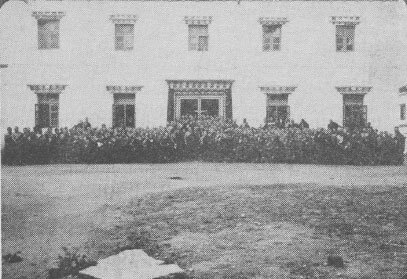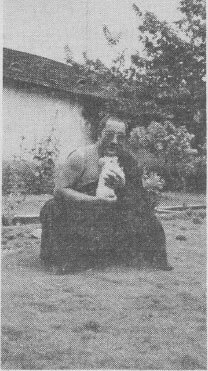| The following article is from the Winter, 1990 issue of the Snow Lion Newsletter and is for historical reference only. You can see this in context of the original newsletter here. |
Shortly after construction of the Potala Palace in Lhasa began, an incarnation of the great translator Variocana was born into the ancestral family of King Tritson Duetsen. At an early age he was recognized as a terton, a treasure discoverer, destined to discover specific texts hidden by Padmasambhava in the eighth century. Enthroned at the end of his tenth year as Terton Migyur Dorje, he became a prolific terton recovering twelve volumes of termas before passing away at the age of 23.
The Namcho terma of Migyur Dorje became the main practice of the Palyul Lineage of the Nyingma school when its monastery was founded in the late 1600s by Vidhyadhara Kunzang Sherap, a student of Terton Migyur Dorje. In this lineage the kama and terma traditions, as well as Mahamudra and Dzogchen, are practiced together like two streams flowing into one great river. The terma treasures of nine different Tertons are included in the Palyul lineage, namely Migyur Dorje, Karma Lingpa, Ratna Lingpa, Jigme Lingpa, Orgyen Terdak Lingpa, Ngadhak Ngang, Lama Gongadu, Mati Ratna, and Rigdzin Jetsun Nyingpo. Over time the Paylul Monastery grew to be one of the six great Nyingma mother monasteries of Tibet. With the invasion of Tibet by the Chinese in the late 1950s, His Holiness Pema Norbu Rinpoche, the eleventh throne holder, was forced to flee with a handful of monks and relocate in southern India. (Snow Lion has published the book about the Palyul Nyingma Lineage. The Garland of Immortal Wish-Fulfilling Trees is available for $15.95).
Today there are over 500 monks at Palyul Namdroling Monastery in Bylakuppe, India. Inspired by the vision and efforts of His Holiness Pema Norbu, monks train in traditional Nyingma practices of ritual, dance, study and meditation, including jaling (traditional monastic music).

Palyul Namdroling Monastery
Nearly 200 monks are now studying at the Scholastic College. The monks rise at 5 AM and study until breakfast at 7 o'clock. Classes are held six mornings a week from 8:30 to 10:30. In the afternoon they engage in debate and in the evening study until 9 PM. After completing the nine year program and passing a final exam, they are awarded the tide Achyara (equivalent to a M.A.). In order to become a Khenpo (equivalent to a Ph.D.) the candidate must examplify stable moral conduct and undertake research culminating in a thesis paper. Once both of these have been assessed, it is up to His Holiness to confer the title of Khenpo. As Khenpos and Achayaras the monks are sent to Nyingma and Kargyu monasteries throughout India, Nepal, and Bhutan to teach.
The remaining monks in residence in the zhungtra (monastery) are responsible for upholding the traditions of the Tibetan Nyingma doctrine. In addition to the monthly full and new moon rituals, and tenth and twenty-fifth day tshog offerings, they perform week long accomplishment ceremonies two or three times a year. These involve the continuous repetition of a specific mantra throughout the ceremony. At the Tibetan New Year an accomplishment ceremony has been performed for nearly thirty years alternating between the recitation of Guru Siddhi and Mani mantra. It is said that if you participate you recieve the benefit of 100 million mantras. Occasionally during the ceremony chosmen (dharma medicine) may also be made. Medicinal herbs are mixed and blessed by the power of the practice being performed. This medicine has the power to alleviate sicknesses that ordinary medicines cannot help.
The monks of Palyul Monastery are taught to read and write and given a basic Buddhist education. Once a year they are given the op-portunity to undertake one-month retreats on Ngondro, Tsalung (breathing and yogic exercises) of Dzogchen. After years of training in the monastery a monk may enter into the traditional three-year tantric retreat and become a Dorje Lobon after completing the retreat. Twelve monks have completed the three year retreat so far and twenty-two have just begun a new one.
Nyingma traditional dance is a special feature of the Palyul tradition. In the late afternoon monks practice new dances in the courtyard of the monastery. There are peaceful and wrathful dances, there are dances to please Padmasambhava and to bring auspiciousness. All of the dances are the original gestures discovered by Tertons according to their visionary experience. They are for eliminating famine, disease, or unwanted incidents and obstacles. It is said that by seeing the kama dances incurable diseases can be cured.
Recently His Holiness enabled twenty-six lay people to learn the traditional Ling Gesar dances by bringing a teacher from Orissa, India to train the young dancers. He organized both the instruction and costumes. Thirteen different types of dances are now regularly performed at the monastery. The dances are the mind treasure of Mipham Rinpoche and are an offering to King Ling Gesar.
His Holiness is both the spiritual and financial mainstay of the monastery. He personally supervises the education of thirteen Tulkus in residence, eleven of whom are incarnations of lamas from the Palyul lineage. They are being trained to become the spiritual heads of monasteries in Tibet, Nepal, and India. His Holiness is the Master of Ceremonies for all monastic rituals and frequently travels to branch monasteries and Dharma centers throughout the world. He also oversees the construction of new buildings and supervises all other activities of the monastery, including an old people's home for lay Tibetans without family or relatives.

H.H. Pema Norbu Rinpoche
His Holiness' favorite pastime is spending time with animals. Next to his house is a beautiful garden inhabited by swans, exotic birds, a minature deer and numerous cats and dogs. One of the dogs, named Sonam, follows His Holiness everywhere including the shrineroom where he sits behind His Holiness' Dharma throne. In the reception room next to His Holiness' seat is a box containing a small white mouse that His Holiness acquired in Singapore. There are many stories of his great kindness to animals and of his going to great expense to bring animals back from Tibet and Europe.
Palyul Namdroling Monastery, nestled in the sandalwood forests of southern India, is a source of hope and inspiration for all Dharma pracitioners. Currently the monastery is building new classrooms and dormatories for the Scholastic College, in order to provide better facilities for its students. There are plans to build retreat compounds for lay people who are interested in doing long retreats. The Palyul lineage, which thirty years ago appeared to be on the verge of exinction, is alive and flourishing in southern India.
Anyone interested in visiting Palyul Monastery should write the Secretary for further information. A 'Special Permit' is required from the Indian government in order to visit for more than a few days. Contact: The Secretary, Nyingmapa Monastery, Aralikumari, P/O Bylakuppe 571104, Dist. Mysore, Karnataka, Southern India.

